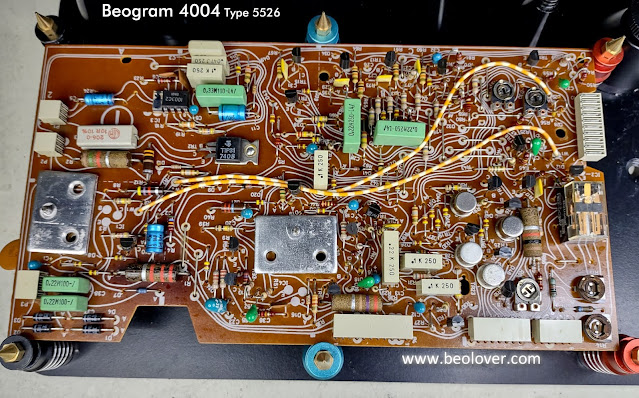In this post I performed the restoration work on the main board (PCB 1) and the output board (PCB 8).
However, I started off the capacitor replacement in the cabinet with the power supply 4000uF filter capacitor. I replaced the old electrolytic capacitor with a new Nichicon electrolytic capacitor in Beolover's 3D printed housing. The power supply filter capacitor style changed on various types of Beogram 400x turntables. This Type 5526 Beogram 4004 uses a single filter capacitor.
Next I started in on removing the main board and the output board for their restorations.
While doing that I did some more assessment on other components inside this Beogram.
The button control panel works fine but I can see that the switch contacts will likely need some cleaning.
It is necessary to remove the button panel and disconnect three cable connections to get to the output board (PCB 8).
There is an audio muting circuit there that switches the audio signals (Left & Right) to ground when the phono signal is muted.
PCB 8 also contains an early remote control system between a Beomaster 2400 and a Beogram turntable. The Beomaster 2400 contains the actual remote control. It uses an additional two pins in the phono cable DIN connector (pins 6 & 7) for the wired remote control integration with the Beogram 4004.
PCB 1 is the main board and contains all of the Beogram analog control circuits.
I removed the boards from the cabinet to do the restoration work on them.
I usually begin with the PCB 8 output board because it is smaller and easy to do first.
One thing a little interesting on the audio output circuit is the signal ground and system ground connections on the output cable connector. Some Beogram 4002/4004 turntable PCB 8 boards have a small capacitor (8C2, 47nF) between those pins. This Beogram 4004 has that capacitor removed. I have seen this on several Beogram 4004 units and I am not sure whether there was some B&O service bulletin about it or not.
Since this PCB 8 board had 8C2 removed I decided to use those PCB holes to mount a small toggle switch that will connect/disconnect signal ground withe system ground. This can be used to make that selection choice when addressing any hum in the phono signal between the Beogram 4004 and an amplifier.
I replaced all of the electrolytic and tantalum capacitors 4.7uF and smaller with WIMA MKS non-polarized capacitors. I also replaced the original, National muting relay with the Beolover Omron replacement.
That takes care of the output board.
Now on to the main board.
I used the same strategy on the capacitor replacement but I should note the in many cases, including this one, I have found that the existing tantalum capacitors are often still good. I still like replacing them with WIMA non-polarized capacitors as that should mean one less thing to worry about in the future. Preventative maintenance I believe it is called :-).
Many times however, we get Beogram control boards from units that were not stored in good environments so we definitely want to change the tantalums and electrolytic capacitors in that case.
I will change out two trimmer resistors on this board. 1R15 (33 1/3 RPM adjustment trimmer) and 1R14 (45 RPM adjustment trimmer). The speed selection relay will also be changed from the original National relay to the Beolover Omron replacement. Beolover has demonstrated many times that these replacements are effective in platter speed consistency along with the platter motor restoration.
Those are key in the Beogram 4002/4004 fixed arm sensor's record detection circuit.
For long term reliability and stability we check the transistor gain to see that it is at least 500.
If not we change the transistor to a new one that is. The 1MΩ 1R26 resistor is changed to a 5MΩ trimmer resistor. Together with the 500 Hfe 1TR3 transistor it will be easy to set the steady state voltage level of 1TR3 so the Beogram 4004 record detection circuit operates at its optimum capability.
The replacement transistor has the collector and emitter leads reversed with respect to the transistor case shape. It is always a good idea to test and check that the orientation of a new transistor matches the original one.
Here is what the new 1R26 and 1TR3 will look like installed in the PCB 1 board.
I soldered the 1TR3 transistor but I will temporarily mount the 1R26 trimmer on the trace side of PCB 1 so I can easily make the setting of the resistance value. Once I have that dialed in I will remount the trimmer as shown above.
Here is the reworked PCB 1 board.
Here is the trace side with the 1R26 trimmer temporarily installed for adjustment.
I also placed two PCB 1 capacitors on the trace side so they can't interfere with the floating chassis movement. They sit right above the floating chassis so these WIMA replacements are better on the PCB 1 trace side where they will be out of the way.
That does it for the PCB 1 and PCB 8 restoration work.
The next step will be to reinstall the boards and do some initial voltage checks.

















No comments:
Post a Comment
Comments and suggestions are welcome!